Soil
Healthy soil is critical to successful agriculture and is vital to produce the food and fiber we use every day. When soil issues arise, from soil organism habitat degradation to erosion to nutrient depletion, they can have long-term and costly impacts to soil health and production goals.
Get Assistance for Your Conservation Issues
Review common soil problems below and add issues you may be experiencing to My Conservation Concerns List. If you are experiencing other types of problems, continue to build your list by exploring the categories at the bottom of each page.
When you’re done, click Build Your List to finalize your list and get connected with free assistance from our conservation experts.
Note: NRCS is not a regulatory agency. None of your answers will be recorded or reported.
Locate Your USDA Service Center

Service Centers Found for County
Select one or multiple Service Centers.
Soil Erosion
Non-concentrated water erosion
Non-concentrated water sources, such as thin layers of water or small streamlets, can cause significant soil erosion damage if left untreated. This type of erosion can be classified into one of two categories based on how the water flows and the pattern of erosion.
Uniform shallow erosion
Water that flows uniformly over a wide surface can remove soil in thin layers (sheet erosion). This type of erosion can cause significant damage as it can cover large areas of land before a problem is identified. If left untreated, sheet erosion will gradually wash away important nutrients from the topsoil and can lead to unproductive soil.

Erosion in a conventionally-tilled field in Carbon County, Montana
Small streamlet erosion
Rainfall and runoff can cause small channels of concentrated water to form on land which can create streamlets (rills) that remove soil (detachment).
Causes
- Bare or unprotected soil (i.e. lack of plant cover or residue cover)
- Long and/or steep slopes
- Intense rainfall or irrigation events when residue cover is at a minimum
- Decreased infiltration by compaction, surface sealing, etc.
Possible Solutions
- Residue management
- Crop rotations
- Cover crops
- Adopting a soil health management system
- Terraces
- Contour farming
- Stripcropping
Resources
Wind erosion
Wind erosion causes damage to land by transporting soil, which can cause soil loss, dryness, and soil deterioration. This type of erosion often occurs on flat, bare areas, where the soil is sandy, dry, and loose.

Erosion by wind in Sheridan County, Montana
Causes
- Bare or unprotected soil (i.e. lack of plant cover or residue cover)
- Long, open fields
- Strong wind events when residue cover is at a minimum
Possible Solutions
- Residue management
- Crop rotations
- Cover crops
- Adopting a soil health management system
- Contour farming
- Stripcropping
- Windbreaks
- Herbaceous wind barrier
Resources
Concentrated water erosion
Concentrated streams of running water can cause soil erosion by creating sharp ditches or small valleys in land (gullies). This type of erosion can be classified into one of two categories based on the size and pattern of the damage.
Wide and shallow erosion
Certain events can cause temporary, wide areas of soil erosion that usually doesn’t run deeper than the tilled layer (ephemeral gullies). They typically occur in the same flow area and while they can usually be fixed over time through the use of conservation practices and minimized through practices that build soil health.
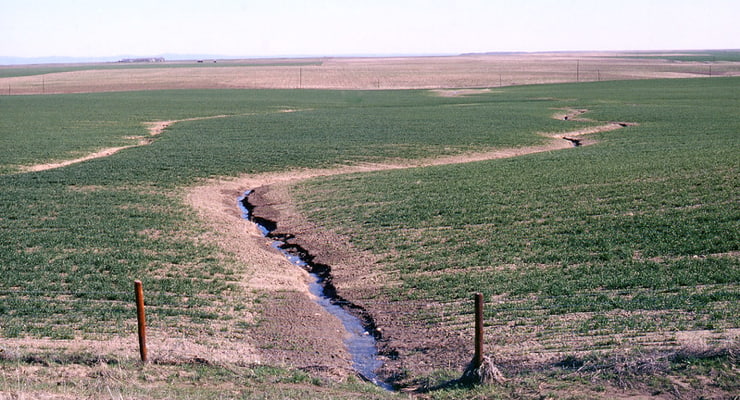
Ephemeral gully in Hardin, Montana
Deep and narrow erosion
Running water can sharply erode soil and create large ditches or small valleys (classic gullies). If left untreated, these gullies may grow and create short cliffs or bluffs (head cutting) and grow deeper and wider when water removes soil from the stream’s bed or valley’s floor causing the banks to collapse (lateral widening).
Causes
- Bare or unprotected soil (i.e. lack of plant or residue cover)
- Excess runoff
- Poor water infiltration into soil
- Inadequate outlet for water
Possible Solutions
- Residue management
- Cover crops
- Adopting a soil health management system
- Terraces and/or grassed waterways
- Grade stabilization structure
- Lined waterway or outlet
- Water and sediment control basin
Resources
Erosion along bodies of water
Erosion that occurs on banks and shorelines can degrade water quality from the additional sediment that is added. This type of erosion occurs along large bodies of water such as lakes, rivers, and oceans, and also along smaller bodies of water such as streams.
Shoreline erosion
Shores of lakes, streams, rivers, and coastlines are naturally predisposed to erosion due to the moving water.
Bank erosion
Bank erosion occurs when the banks of a stream or river are gradually worn away. Water can erode soil and sediment underneath trees which can cause roots bound to soil to stick out over the water (abutments), however erosion can also occur in places where there are no trees.
Channel erosion
Erosion that occurs within areas between high banks (channels) is called channel erosion. Channel erosion can occur along a streambank, which directly erodes the bank, or directly along the streambed, which lowers the bed.
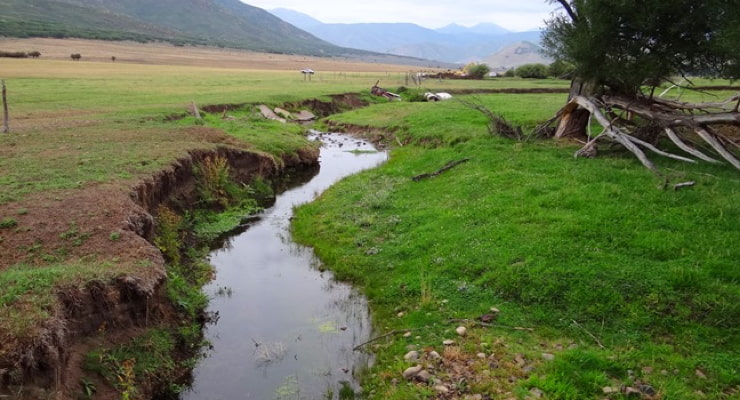
Channel erosion in Wallsburg, Utah
Causes
- Increased runoff due to land use changes and degraded soil health in the watershed
- Large runoff events
- Degraded riparian areas
- Uncontrolled livestock access
- Tillage or other disturbance close to the stream bank
Possible Solutions
- Watershed-wide adoption of soil health management systems
- Bank armor and protection
- Soil bioengineering practices
- In-stream structures
- Native material revetments
- Riparian areas with native or locally adapted vegetation
- Control livestock access to the water bodies
- Vegetative buffers
Resources
Increased soil salinity in coastal areas
Traditional row crops have a low tolerance to salt. Increased salinity affects the process of osmosis, resulting in water being pulled from the plant. The loss of water can dehydrate and destroy crops.

A field showing the effects of increased salinity due to saltwater intrusion in Hyde County, North Carolina.
Causes
- Saltwater intrusion
- Sea-level rise
- Saltwater migration into field drainage systems
- Subsidence
- Saltwater inundation from storm surge
- Loss of protective marshes and coastal erosion
- Over irrigation from coastal wells affected by saltwater intrusion
Possible Solutions
- Salt-tolerant crops
- Restore or create protective wetland/marsh buffers
- Convert salt-damaged land into wetlands
- Reduce the amount of irrigation water pumped from the affected well
Reduced Soil Health and Quality
Ground settling or sinking
Subsidence
Subsidence is a loss of soil volume and depth caused by oxidation of organic matter in peat, bog, and muck soils. Soil scientists call these soils “Histosols.” The loss of soil volume is caused by organic material breaking down faster than it accumulates. Subsidence reduces an organic soil’s productivity, creates drainage problems, makes trees vulnerable to windthrow, and causes other land management problems. Naturally occurring sinkholes; and sinkholes and depressions caused by underground activities are excluded from the NRCS subsidence resource concern.
Excessive water drainage, soil disturbance, and extended drought are the leading causes of subsidence. Subsidence occurs slowly over time. To know if subsidence has occurred:
- Verify if your soil is a Histosol by using Web Soil Survey or by contacting a local USDA Service Center to gather information about your soil.
- Next, look for soil that has shrunken away from live tree roots, or away from some permanent fixture on the land like a road, or utility pole. Subsidence can occur across a whole field, or it may occur irregularly, creating depressions within a field.
Subsidence in organic soils may not be reversible, but the loss of organic matter can be slowed in cropped areas by managing water table levels at the optimum level for the crops being grown and minimizing tillage intensity. In non-cropped areas, managing for water close to the surface year-round can slow subsidence.
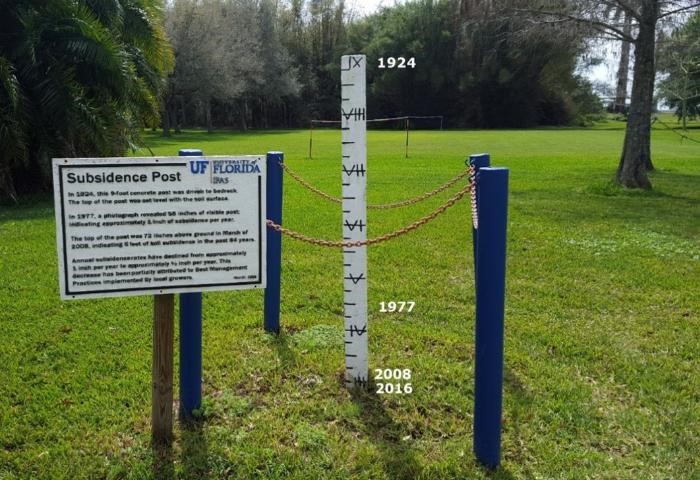
Causes
- Drainage
- Cultivation/Soil disturbance
Possible Solutions
- Water table management
- Perennial crops
- Diverse, high biomass crop rotations
- Conservation tillage
- Cover crops
- Wetland restoration
Resources
Soil compaction
Soil compaction occurs when soil particles become compressed. This can cause the soil to become overly dense which can impact the rate of drainage and saturation, can cause aeration-related problems, and can make it harder for roots to effectively penetrate the soil. Because soil properties can vary across the landscape, different soils have different risks for compaction. Management activities that cause compaction in one soil may not cause compaction in another.
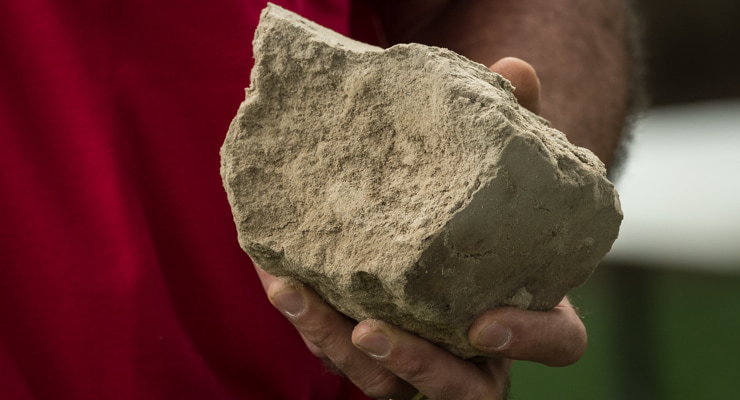
Dry, compacted soil in Virginia
Causes
- Working wet soil
- Excess traffic, machinery or livestock
- Heavy machinery
- Repeated tillage at the same depth
- Poor aggregation
- Low organic matter
- Poorly managed grazing in pasture and range systems
Possible Solutions
- Avoid working wet soil
- Reduce traffic/tillage operations
- Rotate crops
- Controlled traffic patterns
- Subsoil or rip compacted areas
- Diversify cropping system
- Conservation tillage or no till
- Cover crops
- Animal manures and compost
- Non-compacting tillage
- Grazing management
- Adopt soil health management systems
Resources
Organic matter depletion
If soil cannot adequately provide nutrition for plant growth, animal habitats, or soil biological activity, then it may suffer from organic matter depletion.
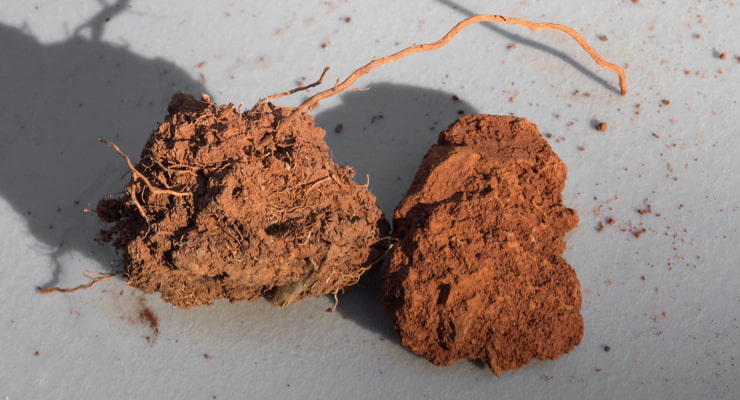
Healthy soil with organic nutrients on the left; unhealthy, nutrient-depleted soil on the right
Causes
- Soil disturbance
- Intensive tillage systems
- Low crop biomass (surface and subsurface)
- Burning, harvesting or otherwise removing crop residues
- Overgrazing in pasture and range systems
Possible Solutions
- Diverse, high biomass crop rotations
- Cover crops
- Conservation tillage and no till
- Grazing management
- Adopt soil health management system
- Perennials in rotations
- Maintain crop residues on soil surface
- Animal manure and compost
- Water table management
Resources
Salts and chemicals in soil
High levels of salt and other chemicals in soils can lead to pervasive problems such as negatively impacting germination, seedlings, vegetative growth, and a reduction in crop yields.
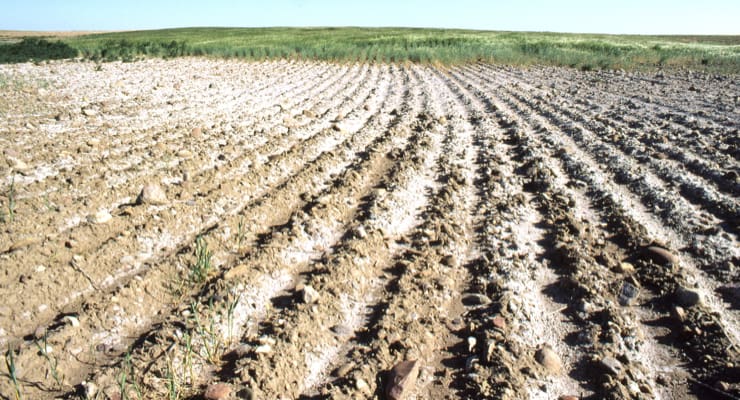
Field with saline deposits in Liberty County, Montana
Causes
- Naturally occurring in soils with high concentrations of soluble salts, e.g., sodium, calcium, and magnesium sulfates
- Inadequate drainage to leach salt from the soil
- Improper irrigation
- Upward migration of salt from shallow ground water
- Application of saline and/or sodic irrigation water
Possible Solutions
- Proper use of irrigation water
- Salt-tolerant crops
- Removal of excess water from recharge areas
- Maintenance of the water table at safe levels
- Cropping and tillage systems that promote adequate infiltration and permeability
- Reducing deep tillage
Resources
Soil organism habitat degradation
Healthy soil is a living ecosystem that contains a diverse community of organisms. These organisms help stabilize and create space in the soil to enable air and gas exchange, allow water to infiltrate and be stored, and create an environment for fauna to reside and plants to grow well.
Soil health is the capacity of the soil to function as a vital living ecosystem that supports plants, animals, and humans. When there is inadequate food, cover, space, shelter, air, or water for these organisms to thrive, soil health is negatively impacted and soil functions degrade, causing a large number of symptoms including erosion, plant health issues, and water and air quality problems. Four principles of soil health management systems contribute to maintaining soil organism habitat: maximizing soil cover and minimizing disturbance protects habitat, and maximizing the presence of living roots and biodiversity feeds soil biota.

Examining soil in Ekalaka, Montana
Causes
- Soil disturbance (physical, chemical and/or biological)
- Fallow periods without living roots
- Low biodiversity in the production system
- Low plant biomass and surface cover
- Burning, harvesting or otherwise removing crop residue
- Simplified crop rotations
- Lack of animal integration in production systems
- Overgrazing, reduce plant production which reduces food for soil biology
Possible Solutions
- Adopt a soil health management system
- Conservation tillage
- Cover crops
- Diverse crop rotations
- No-till cropping systems
- Nutrient management
- Grazing management
- Maintain crop residues on the surface
- Animal manure and compost
- Irrigation water management
- Mulching
- Integrated pest management
Resources
Soil aggregate instability
A soil aggregate, or water-stable aggregate, is made from particles of sand, silt, clay and organic matter that are bonded together. When stable, these aggregates greatly contribute to healthy soils by stabilizing soil carbon, allowing proper water infiltration and water holding capacity, aeration, and more.
Many management activities used on working lands can lead to degradation of soil structure and aggregate stability
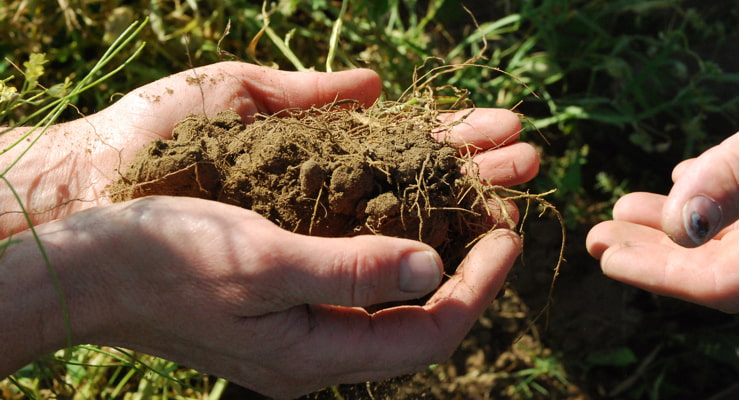
Soil which displays soil aggregates in Havre, Montana
Causes
- Poor soil health
- Degraded soil organism habitat
- Soil disturbance (physical, chemical and/or biological)
- Fallow periods without living roots
- Low biodiversity in the production system
- Low or no surface plant or plant residue cover
- Low crop biomass (surface)
- Burning, harvesting, or otherwise removing crop residue
- Simplified crop rotations
Possible Solutions
- Adopt a soil health management system
- Cover crops
- Diverse crop rotations with high residue crops
- No-till/Strip-till cropping systems
- Nutrient management
- Grazing management
- Maintain evenly spread crop residues on the surface
- Well-managed animal manure and compost
- Irrigation water management
- Mulching
- Reduced tillage
- Pest management conservation system
Resources


My Conservation Concerns List
The concerns you add will appear below. When you’re done adding issues, click the button below to finalize your list and find your local USDA Service Center.
